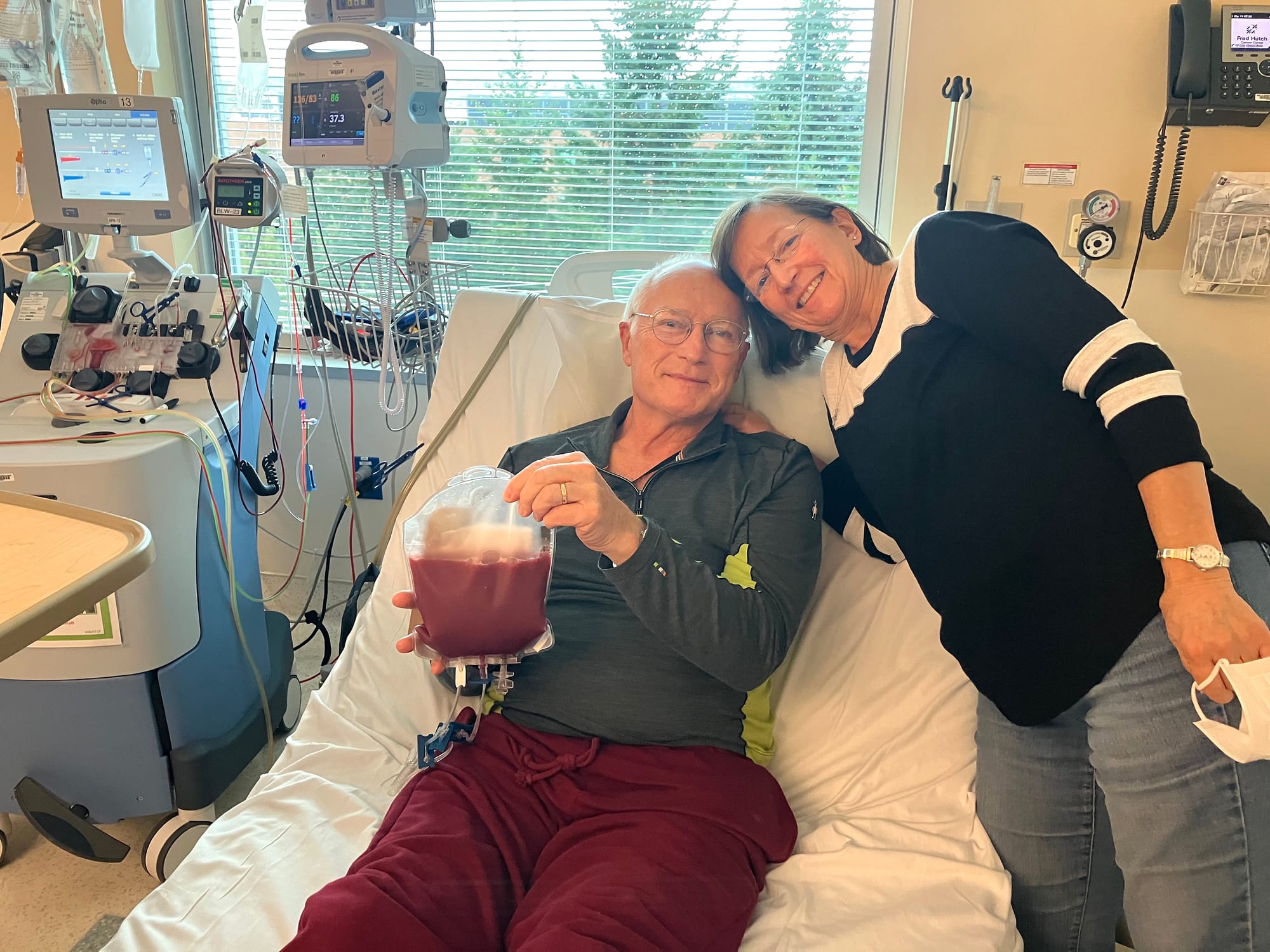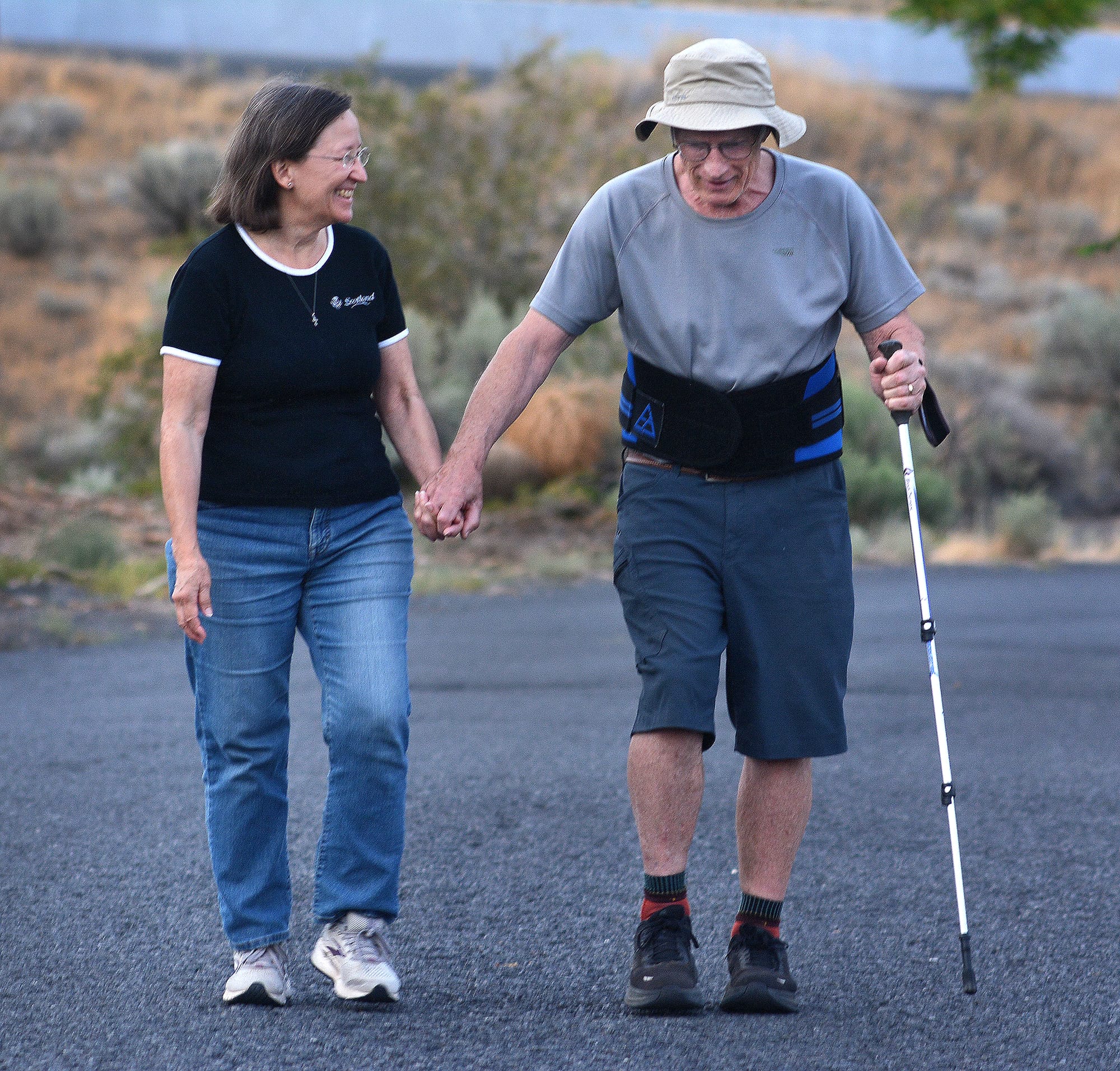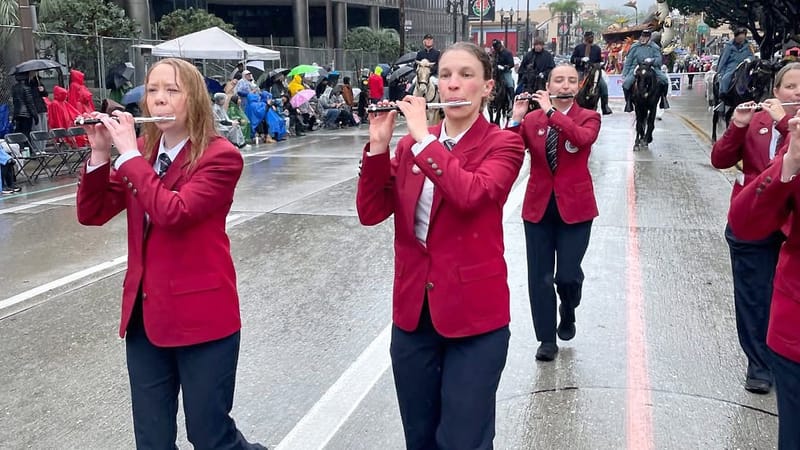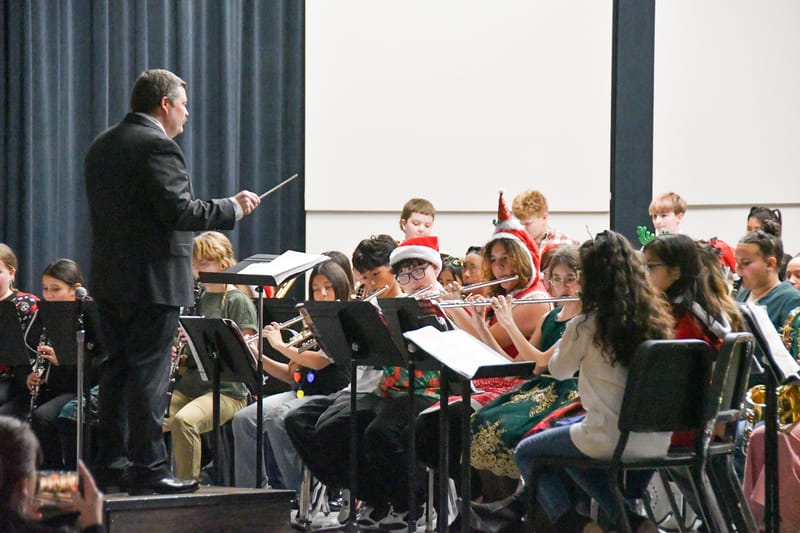Cancer diagnosis tested my faith and family: an essay

Editor’s note: Dan Martell, 70, is a retired Ephrata School District administrator who lives in town with his wife, Susan, a retired pharmacist. The couple also have a cabin residence at Snoqualmie Pass, where Dan sustained broken vertebrae in his lower back while wrestling with a snowblower in January 2024. An initial misdiagnosis of his injuries started a chain of events that eventually resulted last spring in learning he had a rare form of cancer. Dan penned an essay shared with family and friends about his prolonged treatment and recovery over the past year and provided this edited version for GCJ.news. In doing so, he hopes to inform readers about the trials and tribulations, hopes and fears, in facing a long-term, life-threatening illness.
BY DAN MARTELL
EPHRATA – On Friday, May 12, 2024, at 10:30 a.m., just before Mother’s Day, a physician assistant at my doctor’s office called me at home, saying a blood sample sent to the University of Washington for analysis had finally returned.
David, the doctor’s PA, apologized for contacting me by phone.
“I hate to call you, rather than talk face-to-face,” said David, “but I knew you were waiting for these results. I’m sorry to let you know the blood tests indicate you have multiple myeloma.”
Bewildered, my first reaction was, “What’s multiple myeloma?”
David then spent several minutes giving me and Susan an overview of the preliminary diagnosis: I had a rare cancer adversely affecting the blood plasma produced by my bone marrow, suppressing my immune system and leaving me vulnerable to other potentially fatal ailments and infections.
After some questions and answers – and his urgent directive to consult an oncologist “ASAP” – we hung up the phone, numb.
“What does this mean?” I asked myself.
The squirrel cage in my head began spinning. And I cried like a little kid.
- - - - -
The next several weeks became a swirl of appointments with my oncologist – a medical doctor specializing in the diagnosis and treatment of cancer – along with more intensive testing and developing “The Plan.”
Gradually, my diagnosis was becoming less abstract, dispelling the notion that cancer only affects “other people.”
It wasn’t supposed to be like this for me. I don’t smoke or chew tobacco, or bake on the beach, or live near a hazardous waste dump. I slather on SPF 50 sunscreen and wear wide-brimmed hats when gardening. I go to church religiously.
I wasn’t supposed to get “The Big C.”
Wrong.
Susan and I delayed telling our two adult children, Danny and Anna, what was happening until after the diagnosis was confirmed and my treatment plan prepared. Still, it was emotional and difficult.
They, too, were caught off guard as we all navigated this new life we were embarking on. I say ‘we’ because every cancer patient – or anyone affected by a long-term disease – produces a ripple effect on all the people who have touched their lives.
Next, we notified our church pastor and then our eight siblings. A lot of calls, all difficult. But it became almost cathartic to share where we were with my cancer – it became more real and the repetition began to dull my personal shock. At least for a while.
- - - - -
Over the next three months, a weekly routine developed: On Wednesday, drive to the Moses Lake cancer center and get my dose of chemo shots, steroids, Benadryl and Tylenol; feel pretty good Thursday and Friday until the steroids wear off; feel pretty lousy from Sunday until the following Wednesday when the next round began. Repeat for 12 weeks. At the same time, my injured back was also ailing me in a big way.
The staff quickly learned my name and we visited each week. They were professional and compassionate.
My faith was tested. I didn’t do as good living up to Philippians 4:6-7 as I’d wanted. Both Susan and Pastor Nathan helped keep up my spirits.
One of the ‘silver linings’ that emerged during this period was a reconnection between some of my siblings, ages 68 to 76, who united in their support. One sister crafted some 30 hats with the logo “Multiple Myeloma Warriors, Team Martell” for all our families to wear at a reunion. What a blessing to me. Thank you, Lord!
- - - - -
Last fall, all preliminary treatments were completed and I was considered to be in “temporary remission.”
Multiple myeloma is a complex condition with different levels of severity and no specific cure. It inhibits stem cells produced in the body's bone marrow. Stem cells are vital: they're unspecialized cells which can divide and renew themselves, or develop into specialized cells such as muscle or blood cells. By doing so, they replace old or damaged cells that form our tissues.
The doctors said my variant was rare and aggressive. At that point, I had three options:
– do nothing (not a good choice);
– do a limited-treatment regimen, understanding that the myeloma would likely return in two to three years;
– undergo what’s called an “autologous bone marrow transplant.”
In this latter process, my treated stem cells – now in remission from cancer – would be “harvested” from my body. Afterward, my diseased bone marrow which produces the stem cells would be “chemo killed.” Then my harvested-and-treated stem cells would be reinfused back into my bone marrow.
My local oncologist and the staff at the renowned Fred Hutchinson Cancer Center in Seattle recommended the transplant, believing it would provide the best opportunity for a longer-term remission and living a “pretty normal” life span.
The process was set to start Oct. 9 and my stay in Seattle would be a minimum of 10 weeks. Susan was on board as my designated caregiver – I could not be accepted as a patient without one.
This was all coming at us at a dizzying pace: making arrangements to pay bills, collect mail, and care for our home in Ephrata while moving into temporary housing near “The Hutch.”
It seemed a huge unknown and a tremendous leap of faith, both in our Lord and the staff at FH. But we knew we couldn’t be in a better place.
Susan and I initially stayed in the Behnke Family house, which is provided to long-term patients at FH, located less than a mile away. We had a nice room with a common kitchen and laundry. It was a wonderful transition from rural central Washington to downtown Seattle. After three weeks, we moved into a one-bedroom apartment at the Pete Gross House, a 70-unit apartment complex located even closer to the Hutch. Pete Gross – a Seattle sportscaster known as the “Voice of the Seahawks” who died of cancer in 1992 at age 55 – was instrumental in creating a vision and fundraising to create this living space for out-of-town cancer patients. Daily shuttle service made it incredibly convenient for the multitude of daylong appointments and procedures.
It was rigorous but necessary, and the Fred Hutch staff are incredibly meticulous, patient, and positive. I cannot applaud enough about their professionalism and care.
After three weeks of testing to ensure my internal organs could handle the “chemo kill” process, my stem cells were extracted by an apheresis machine, which involved sitting on a hospital bed for two consecutive six-hour days while the machine’s centrifuges quietly spun, sucking out and processing my blood.
I had the next five days ‘off’ to recover before starting a chemotherapy regimen with a drug called Melphalan. It’s among a group of “alkylating agents” which inhibit DNA and RNA synthesis, killing tumor cells.
Even as I prayed for strength and courage, my mind would drift to the ‘what ifs.’ But during this time of inward reflection, my wife, pastor, brother and sisters, and many friends sending cards – all were incredibly encouraging. A lot of people, God’s hands and feet, rooting for my success. It makes a difference. Let’s return again to Philippians 4:6-7.
Sunday, Nov. 17, was my scheduled ‘chemo’ day. The decision had been made. Now it was getting put into motion.
- - - -
I think the hardest part of that day was keeping ice in my mouth.
The actual ‘chemo’ infusion lasts less than 30 minutes. But the cell-killing effects of treatment show up later, including painful mouth sores. However, after years of treating others, the medical staff learned the effects are significantly reduced if patients kept ice in their mouth continuously for 4 to 5 hours to constrict blood vessels. Necessary, but not easy.
One doctor described my pending reaction to the chemo-kill treatment as “a time bomb.” There were no immediate symptoms, he said, but they would arrive a few days later.
Tuesday, Nov. 19, marked the first of two days of infusing the harvested-and-treated stem cells back into my body. They were brought into the room in a liquid nitrogen container and then warmed up to body temperature in a water bath. It looked like a turkey roaster.
A month earlier, in October, I had turned 70. But the nurses told me Nov. 19 would be my new “birthday” because it gave me a new chance at living a normal life.
Several days following the transplant consisted of routine procedures. Blood draw in the morning followed by liquids and nutrients drip-tubed into me via Hickman line for 4 to 6 hours to keep my fluid levels up. The staff was very concerned with flushing the toxic treatment chemicals out of my system and keeping my kidneys in good shape.
All the while, I was preparing emotionally for the chemo-effects ‘time bomb’ to go off. And did it!
Approaching Day Six post-transplant, I felt increasingly worse. Between loss of appetite, diarrhea, vomiting, extreme fatigue, and trying to keep up on the essential daily fluids, I was literally wiped out.
By Day Nine, I could barely swallow and was utterly spent. We decided it best to hospitalize me at the University of Washington. Previously, staff asked me many times when I arrived if I would like a wheelchair. This was the only time I accepted.
I need to interject here: throughout this journey, Susan was a rock of comfort to me. After 42 years of marriage, the vows “for better or worse” certainly played out. She was able to assume all my decisions, understand the doctors and staff, keep up with my regimen of medicines, feed and care for me.
The only thing Susan asked of me during this time was to not go into the hospital on her birthday, which happened to fall on Thanksgiving Day. As hard as I tried, it did not work out. I went into the hospital on her birthday and ended up staying there for six nights. We’re planning a bigger birthday celebration in the future to make amends.
Days 16 through 30, I gradually began feeling better. While not exactly the Jenny Craig diet, I had dropped to my high school weight and was trying to eat again. As the nutritionist said, “Your medicine right now is eating.”
Those days became a blur. Get up, take the shuttle to the Hutch, blood draw or Hickman flush of my ‘central line,’ fluid infusion for 4 to 6 hours, staff review, shuttle back to apartment, repeat.
But during the final two weeks I could see light at the end of the tunnel. I wanted to get home. Fluid infusions were cut in half. To get discharged, I had to keep up my fluid intake without infusions and eat at least 60% of a normal diet. It worked out I was able to be discharged on exactly post-transplant Day 30, which was Dec. 20.
- - - - -
On my last morning in Seattle, Vanessa, our assigned nurse, walked down the hall with Susan and me. We were greeted by the FH staff shaking a chorus of congratulatory bells. Christmas was only five days away. What a beautiful gift to celebrate completion of the bone marrow transplant and remember the birth of Jesus. I struggled to hold back tears. It was not only about the apparent success of my treatment, but also the emotional investment staff members put into their patients. They need the success to be able to keep up their own spirits doing such difficult work.
Our son and a nephew came to the apartment, loaded up two-and-a-half months of accumulation, and we made it over Snoqualmie Pass without any hiccups to our home in Ephrata.
Driving up, we were greeted by the 40-foot spruce tree in our front yard which some dear church members decorated from top to bottom with bright holiday lights.
Merry Christmas indeed.
POSTSCRIPT
This procedure gave me a second birthday, Nov. 19, and the chance at living a normal lifespan. This spring, our local oncologist – who has been so supportive during this journey – said a bone marrow biopsy and PET scan showed no sign of disease or bone damage. I was officially in remission. A year earlier, he doubted whether I would live another six months without the transplant.
My exit doctor at Fred Hutch remembered how sick I was upon my initial arrival. “Yes,” I agreed, “I didn’t feel good at all.’ During our time in Seattle, Susan and I met others also undergoing cancer treatment – our common bond. But each had their own story to tell, and their own journey to travel.
MM is a silent killer, essentially destroying the body’s immune system. An undiagnosed person suffers other seemingly unrelated ailments and often dies from an infection such as pneumonia or the flu. While not currently curable, it is very treatable. I’m now on a ‘maintenance’ medication regimen to stay in remission.
Flashback to January 2024 and the snowblower wrestling match that broke my back. It turns out about 25% of MM patients sustain vertebrae fractures. It’s a mystery why. My back still hurts, but I am now walking one to two miles a day. And I’ve started riding my (electric) bike again, and researching the thousands of riding trails nationwide, some of which I would love to visit.
A good friend wisely counseled me, “Make Each Day Count.”
I am getting better at living as a ‘human being’ rather than a ‘human doing.’ It is hard, but old dogs can learn. You, too, can do this journey.






